For FSU football, the Cook-Akers comparisons happened instantly and it didn’t take long for fans everywhere to declare Akers to be the heir to the throne.
At first it almost seemed unfair for FSU football fans or experts to compare to of the best running backs in recent Seminoles history. Cook, after all, became FSU’s all-time leading rusher and posted back to back 1,600+ yard seasons for the Seminoles – while lofty expectations and an enormous amount of pressure was put on Akers to produce at an elite level so soon.
Akers was a highly touted recruit out of Clinton High School in Mississippi. Both Cook and Akers were five-star running back prospects and measured out at an identical 5’11”, although Akers was a bit larger, weighing out at 213 pounds compared to Cook’s 190. The two were also regarded as one of the best players out of their respective recruiting classes.
According to 247Sports’ 2014 recruiting rankings, Cook was ranked as the No. 13 overall player in the nation and the No. 2 running back (behind Leonard Fournette), and the top player in Florida when he signed with FSU football. Akers had the same exact state and position ranking as Cook and fit the mold of former head coach Jimbo Fisher: a work-horse running back and the comparison seemed fair.
Matching Cook’s historic freshman campaign seemed unlikely for Akers, with Jacques Patrick on the roster, but was not out of the realm of possibility. Cook did face a similar situation to start his career with Karlos Williams, an experienced runner, already on the roster.
While Williams started the season as the Seminoles primary running back, Cook was able to make the most of a limited opportunity and turned it into 1,008 rushing yards, breaking FSU football’s freshman rushing record. Cook’s homerun ability and elusiveness helped him overtake Williams as Florida State’s lead running back with 170 carries and eight touchdowns – 20 more carries than Williams.
Because of Patrick’s presence on the roster, it took a few games for Akers to really see that much involvement in the running game. By week four, however, Akers finally saw a heavy workload where he finished with 121 yards on 20 carries against a stout Miami defense. Coincidentally, Cook didn’t see his first 20+ carry game until week five of his freshman season against Syracuse, where he also finished with over 100 rushing yards (122 yards on 23 carries).
Cook and Akers were both able to notch over 100 rushing yards when given 20 or more carries in their first opportunity, proving they could handle being the every down back for the team. Akers finished his first year with 1,025 rushing yards on 194 carries, topping Cook’s freshman rushing record at FSU.
The similarities between Cook and Akers’ freshman seasons are shocking. Both running backs finished the season breaking Florida State’s rushing record and earned third-team all ACC honors. Cook and Akers both also had dominant performances against Syracuse – Cook tallied 122 yards on 23 carries and a touchdown, while Akers finished with a career high 199 yards on 22 carries and two touchdowns.
While Cook finished the season with 24 less carries and with a higher yards-per-attempt (5.9 compared to 5.3), he was on a much more efficient offense on a 13-1 Seminoles team that made the College Football Playoffs alongside Jameis Winston in one of the more prolific offenses in the ACC.
Akers was a part of a mediocre offense led by true freshman quarterback James Blackman. The Seminoles finished the season with a disappointing 7-6 record, where they had to reschedule a game against Louisiana-Monroe just to qualify for a bowl game. Akers was a part of an offense that finished 71st in points per game, and despite FSU football’s struggles, he was able to put together an incredible freshman season.
Next: Top FSU Football Wins All-Time Over Florida and Miami
It will be exciting to see how Akers produces in an explosive Willie Taggart led offense. Look for Akers to continue to follow Cook’s path and put up historically great numbers.
